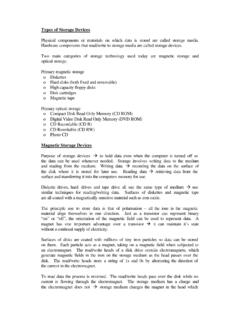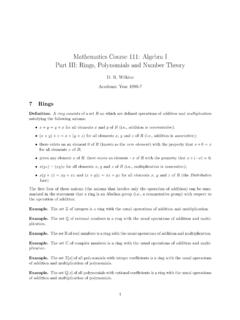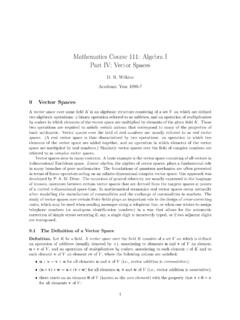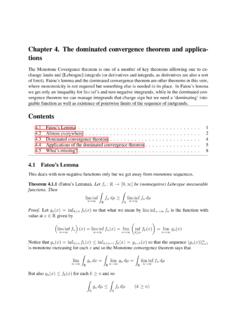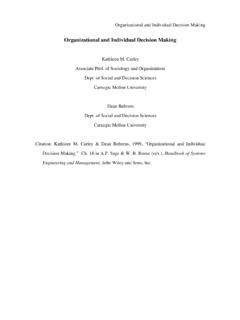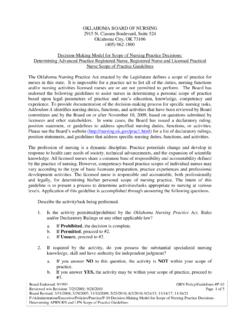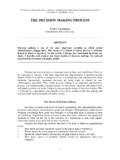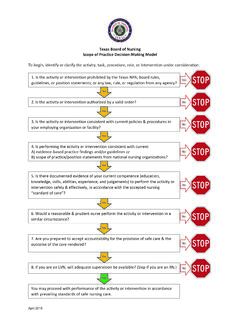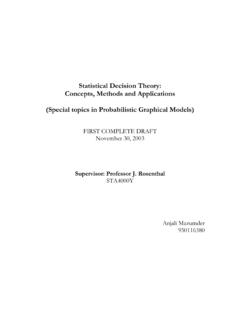Transcription of Levels of Decision making Strategic decision-making ...
1 Levels of Decision making Strategic Decision - making determines the objectives, resources and policies of the organisation. A major problem at this level of Decision making is predicting the future of the organisation and its environment and matching the characteristics of the organisation to the environment. This process generally involves a small group of high level managers who deal with complex, non-routine problems. Decision making for management control is principally concerned with how efficiently and effectively resources are utilised and how well operational units are performing.
2 Management control requires close interaction with those that are carrying out the tasks of the organisation. It takes place within the context of broad policies and objectives set out by Strategic Decision making and the behaviourists have described, it requires an intimate knowledge of operational Decision making and task completion. Knowledge based Decision making deals with evaluating new ideas for products and services, ways to communicate new knowledge and ways to distribute information throughout the organisation. Decision making for operational control determines how to carry out the specific tasks set forth by Strategic and middle management Decision makers.
3 determining which units in the organisation will carry out the task, establishing criteria for completion and resource utilisation and evaluating outputs all require decisions about operational control. Types of decisions: Structured versus Unstructured Within each of these Levels of Decision making , Simon (1960) classified decisions as being either programmed or non programmed. Other researchers refer to these types of decisions as structured or unstructured. Unstructured decisions are those in which the Decision maker must provide judgement, evaluation and insights into the problem definition.
4 These decisions are novel, important and non-routine, there is no well understood or agreed upon procedure for making them. Structured decisions by contrast are repetitive, routine and involve a definite procedure for handling so that they do not have to be treated each time as if they were new. Some decisions are semi-structured decisions; in such cases only part of the problem has a clear cut answer provided by an accepted procedure. Types of Decisions and types of systems Combing these two views of Decision making produces the grid below. In general operational control personnel face fairly well structured problems.
5 In contrast Strategic planners tackle highly unstructured problems. Many problems encountered by knowledge workers are fairly unstructured as well. Nevertheless each level of the organisation contains both structured and unstructured problems. In the past most success in modern information systems came in dealing with structured, operational and management control decisions. But now the most exciting applications are occurring in the management, knowledge and Strategic planning areas, where problems are either unstructured or semi structured. Organisational Level Type of Decision Operational Knowledge Management Strategic Structured Accounts receivable TPS Electronic Scheduling OAS Production cost overrun MIS Semi structured Project scheduling Budget preparation DSS Production facility location Unstructured KWS Product design ESS New products new markets Key: TPS Transaction processing system OAS Office automation system KWS Knowledge work system MIS Management Information System DSS Decision support system ESS executive support system Stages of Decision making making decisions consists of several different activities that take place at different times.
6 The Decision maker has to perceive and understand problems. Once perceived solutions must be designed, once solutions are designed choices have to be made about a particular solution, finally the solution has to be implemented. Simon described 4 different stages in Decision making : intelligence, design, choice and implementation. Stages in Decision making , Information requirement and supporting information systems Stage of Decision making Information requirement Example system Intelligence Exception reporting MIS Design Simulation prototype DSS, KWS Choice What if simulation DSS; large models Implementation Graphics, charts PC and mainframe Decision aids.
7 Is there a problem? What are the alternatives? Which should you choose? Is the choice working? Intelligence consists of identifying the problems occurring in the organisation. Intelligence indicates why, where and with what effects a situation occurs. This broad set of information gathering activities is required to inform managers how well the organisation is performing and to let them know where problems exist. Traditional MIS that deliver a wide variety of detailed information can help identify problems, especially if the systems report exceptions. During design the individual designs possible solutions to the problems.
8 This activity may require more intelligence so that a manager can decide if a particular solution is appropriate. Smaller DSS are ideal in this stage of Decision making because they operate on simple models, can be developed quickly and can be operated with limited data. The third stage, choice consists of choosing among alternatives. Here a manager can use information tools that can calculate and keep track of the consequences, costs and opportunities provided by each alternative designed in the second stage. The Decision maker might need a larger DSS to develop more extensive data on a variety of alternatives and to use complex analytic models needed to account for all the consequences.
9 Intelligence Design Choice Implementation The last stage in Decision making is implementation. Here managers can use a reporting system that delivers routine reports on the progress of a specific solution. The system will also report some of the difficulties that will arise, will indicate resource constraints and will suggest possible improvement actions. Support systems can range from full-blown MIS to much smaller systems as well as project planning software operating on PCs. In general the stages of Decision making do not necessarily follow a linear path from intelligence to design, choice and implementation.
10 At any point in the Decision making process you may have to loop back to a previous stage. For instance one can often create several designs but may not be certain about whether specific design meets the requirements for the particular problem. This situation requires additional intelligence work. Alternatively one can be in the process of implementing a Decision only to discover that it is not working. In such a case one is forced to repeat the design or the choice stage. Individual models of Decision making The Rational model The rational model of human behaviour is built on the idea that people, organisations and notions engage in basically consistent, value maximising calculations or adaptations within certain constraints.



